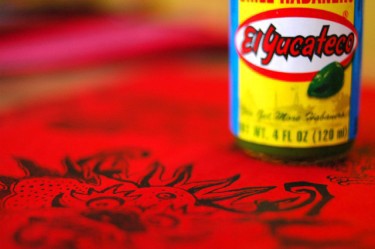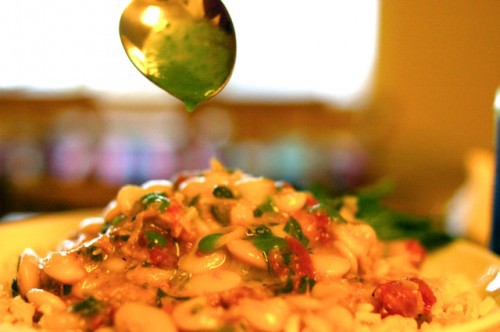Habanero Salsa: Chase The Dragon
by Ben Choi

This is a most auspicious time. The Year of the Dragon is upon us, and as we venture boldly into 2012, towards the edge of the Mayan calendar, let’s turn up the heat with Yucatecan habanero salsa. The dragon is the symbol of transformational power, denoting endless possibility. Habanero salsa is, for my money, the most transformative and versatile condiment you can have on your table. It imparts heat and depth into any savory dish, along with a slightly floral and fruity, yet dry and earthy, flavor profile, and just the right acid balance.
First, a little background on the habanero chili pepper. It’s a thin-skinned, heart-shaped pepper about the size of a ping-pong ball. The ripe ones you’ll usually see in produce aisles are a kumquat-yellow hue, but they can also be harvested earlier, in a pleasing lime-green state (my favorite for salsa). While it probably originated in South America over 8,000 years ago, the habanero, today, is most prolifically cultivated in the Yucatan region of Mexico. It’s rated for heat at 100,000–350,000 units on the Scoville scale, making it, along with its Caribbean relative, the Scotch Bonnet, about the hottest pepper you’re likely to find in a supermarket. But in the grand scheme of hotness, it’s really just over-average. The hottest pepper, according to the Guinness Book, is the Trinidad Scorpion Butch T pepper, which has been measured at 1,463,700 Scovilles. Police-grade pepper spray is at about 5 million Scoville heat units (SHU), I’m told. The jalapeño clocks in at a very reasonable 3,500–8,000 SHU.
Having been known to show off occasionally by biting into a habanero (and having once pepper-sprayed myself in college in a fit of youthful curiosity), I don’t recommend ingesting at any of the above levels of heat. My mother (who was born in the Year of the Dragon) used to wake me in the morning after she’d had a dragon dream and tell me “anything can happen today, be bold, use your imagination… but don’t go surfing.” Habanero salsa is challenging, but not crazy — only about 4,000 to 13,000 on the Scoville scale. You certainly can handle a few drops in your bowl of soup, on your fish taco, over your corned beef hash.

It tastes great on almost anything. To give you an idea of how versatile this condiment is, I’ve been using it on every savory thing I’ve eaten in the past 48 hours. Here’s a list: frozen chicken pot pie, steel-cut oats cooked in chicken stock with chopped green onions, ramen and sardines, baby lima beans with smoked turkey wing, a breakfast burrito and takeout General Tso’s Chicken. Now that’s a flexible condiment; can you use ketchup in ramen or oatmeal? It’s especially good on blandish comfort foods and dishes that are smoky or slightly sweet, such as barbecued ribs or pulled pork. It would be a natural in potato dishes and curries, even on pizza. Use it on anything that needs a bit of herbaceous kick and roughly neutral acidity. It’s not terrifically vinegary for a hot sauce, so it won’t over-irrigate your palate like Crystal Louisiana hot sauce, Sriracha or Tabasco sometimes can.
El Yucateco is the most dominant brand of habanero salsa, and it sets a fine standard for consistency and quality. Made in Merida, Mexico, it’s the Heinz of the Yucatan. I’m especially fond of the green sauce, which I find the most flavorful and multi-use. Look for it in Latino groceries or online. It should run you about 2 bucks for a 4-ounce bottle, maybe a bit more if you buy it online. Be careful, though: unlike many hot-sauce bottles, El Yucateco’s does not feature any kind of regulating spout, so no shaking out the bottle. I usually pour a little onto a spoon and dribble strategically.
And once again, if you do not consider yourself a heat afficionado, please don’t let that get in the way of judicious enjoyment of this fantastic condiment. In the words of the super-group ASIA, when you are in the “heat of the moment,” “catch the pearl and ride the dragon’s wings.”
Gung hay fat Choi.
Previously: Gochujang: Korean Go-to, All-In-One Magic Chile Sauce
Ben Choi will soon go on a diet.
